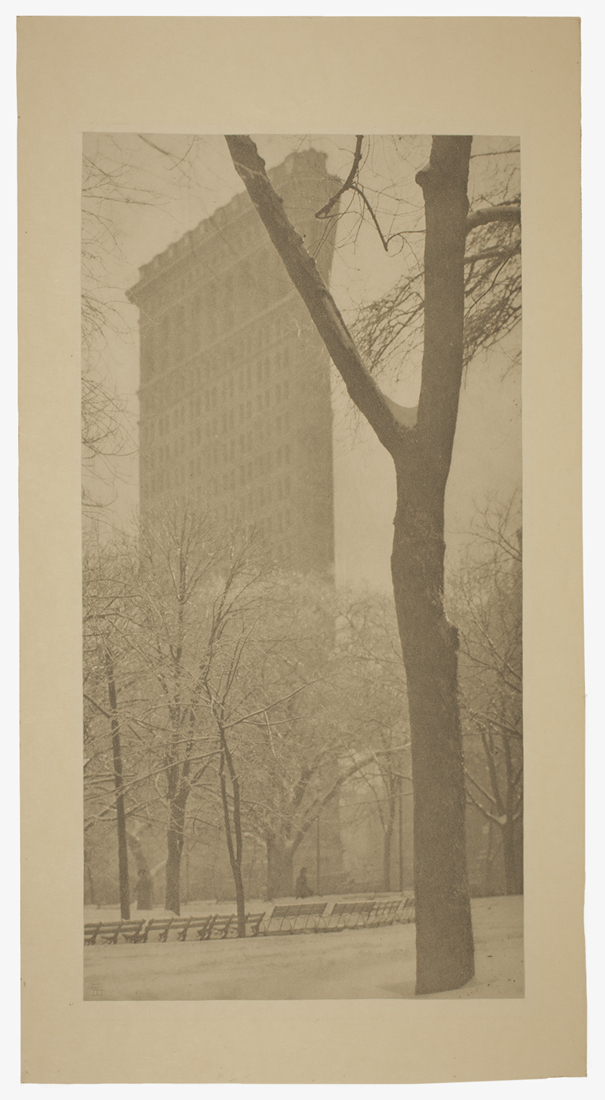Alfred Stieglitz (American, 1864–1946)
The Flatiron, 1903
Alfred Stieglitz Collection, 1949.838
In 1903 a great winter storm left New York City covered with a layer of fresh snow. Alfred Stieglitz seized his hand camera and brought it to Madison Square Park—located blocks from the Camera Club of New York, a frequent haunt of the photographer—where the newly erected Flatiron Building could be seen looming behind the trees. As he later recalled, “I suddenly saw the Flat-Iron Building as I had never seen it before. It looked, from where I stood, as if it were moving toward me like the bow of a monster ocean steamer, a picture of the new America which was in the making.”[1] Later, when his father asked him why he had photographed “that hideous building,” he told him, “That is the new America. It is to America what the Parthenon is to Greece.”[2]
Stieglitz shot several negatives of the scene over the next few days, and he selected this one to be enlarged as a photogravure and included in Camera Work. Many years later, he used a similar negative to make a gelatin silver print, also now in the Alfred Stieglitz Collection at the Art Institute (1949.707). The gelatin silver print is a contact print—uncropped and printed at the exact size of the negative—with a cooler tonality and higher contrast. This differs from the photogravure, which was cropped to emphasize its vertical shape and has a warmer tone and matte surface to provide a softer effect, in keeping with Pictorialist aesthetics.
Additional resources related to this object are to the right.
[1] Alfred Stieglitz, “I Photograph the Flat-Iron Building,” Twice a Year 14/15 (Fall/Winter 1946/47), reprinted in Richard Whelan, ed., Stieglitz on Photography: His Selected Essays and Notes (Aperture, 2000), p. 113.
[2] Ibid., p. 114.
Related Glossary Pages
Artists
Alfred Stieglitz
Through his own photographic work over the course of a half century, the journals he read more
Processes
Photogravure
The earliest method of reproducing photographs in ink, photogravures peaked in popularity at the turn read more
Galleries
Little Galleries of the Photo-Secession/291
The Little Galleries of the Photo-Secession—later known as 291—began as a place to display and read more
Galleries
Anderson Galleries and the Intimate Gallery
With the closure of the gallery 291 in 1917, Alfred Stieglitz found himself without a read more
Galleries
An American Place
At his last gallery, An American Place, Stieglitz welcomed a stream of visitors who wanted read more
Journals
Camera Work
Stieglitz had edited two previous publications—The American Amateur Photographer and Camera Notes—before deciding in 1902 read more
Themes
Pictorialism
The international movement known as Pictorialism represented both a photographic aesthetic and a set of read more
Themes
The Photo-Secession
Following the model of other artistic secessions in Europe around the turn of the century—notably read more
Stieglitz Series
Early Work
As a young man Alfred Stieglitz studied photochemistry in Berlin, and he returned to New read more
Stieglitz Series
New York Views
Beginning when he was a young man newly returned from studying in Germany and continuing read more
Object Research
Key Sources
In: Camera Work 4 (October 1903)
Exhibited: Pittsburgh, 1904
Exhibited: Paris, 1904
Exhibited: London, 1904
Exhibited: Buffalo, 1910
Exhibited: New York, 1924
Exhibited: New York, 1934
Other print of this imageIn Other Stieglitz Collections
The Metropolitan Museum of Art
Museum of Fine Arts, Boston
National Gallery of Art
San Francisco Museum of Modern Art



